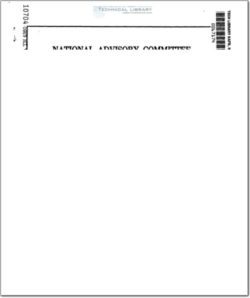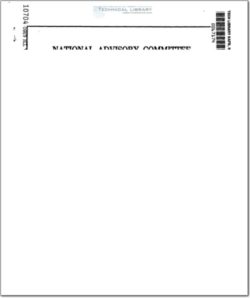NACA-TN-4360

- Version
- 133 Downloads
- 902.46 KB File Size
- 1 File Count
- March 24, 2016 Create Date
- March 24, 2016 Last Updated
National Advisory Committee for Aeronautics, Technical Notes - Measurements of the Effects of Wall Outflow and Porosity on Wave Attenuation in a Transonic Wind Tunnel with Perforated Walls

An investigation was made in a 5- by 5-inch transonic test section
of the wave attenuating capabilities of a variety of perforated-wall
configurations both with and without the use of outflow. The evaluation
was made by comparing static-pressure measurements on a body of revolution
from tests in a 5- by 5-inch test section with those from tests of the
identical model in the Ames 2- by 2—foot transonic wind tunnel.
The test results indicated that reflected disturbances could be
minimized.through the Mach number range tested (M = 1.0 to 1.36) either
by varying the outflow through walls of constant porosity, or by varying
the wall porosity at constant low outflow. At sonic speed only a very
lowsporosity wall yielded minimum interference.
Perforated.walls are used in transonic wind tunnels primarily to
attenuate the reflection of model-induced disturbances from the walls at
supersonic speeds. The attenuation of these disturbances is dependent
primarily on the permeability of the perforated walls and is influenced
by the interaction of the disturbances with the boundary layer (refs. 1,
2, and 3). wall permeability, defined as the capacity of a porous boundary
to pass fluid, is dependent upon many factors of which the primary ones are
porosity and initial outflow; If a porous wall is to be effective in can-
celing disturbances, the boundary layer must be sufficiently thin. This
can be insured‘by inducing an initial outflow through the perforated walls
before imposing the model disturbance field (ref. 3).
The purpose of the investigation presented in this paper was to
determine the relative advantages of two different methods in attenuating
model-induced disturbances in the Mach number range from 1.0 to 1.35.
The first method was to maintain a constant-porosity wall and vary the
permeability by varying the initial outflow. The second technique was
to vary the permeability by varying the porosity with the initial outflow
held small and constant.
| File | Action |
|---|---|
| naca-tn-4360 Measurements of the Effects of Wall Outflow and Porosity on Wave Attenuation in a Transonic Wind Tunnel with Perforated Walls.pdf | Download |

Comment On This Post